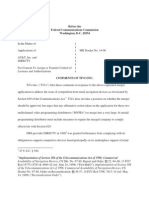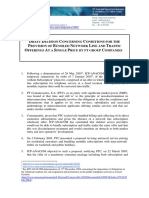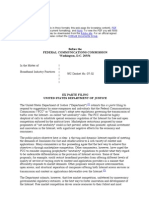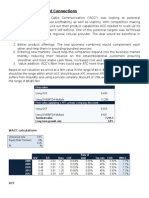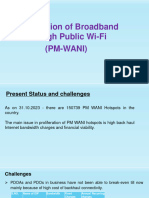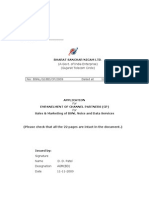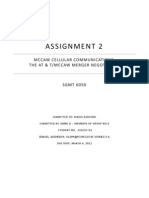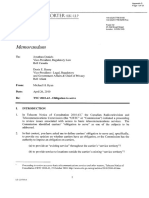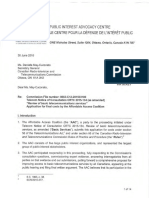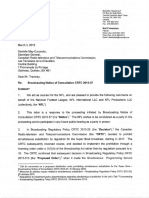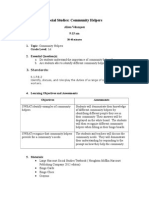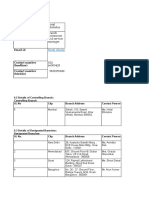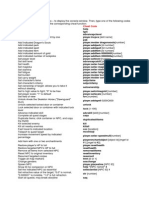Professional Documents
Culture Documents
120109-The - Comp-CRTC-4Jan12-1 TNs BA392-BC7339 - ABR
Uploaded by
Mark GoldbergOriginal Description:
Original Title
Copyright
Available Formats
Share this document
Did you find this document useful?
Is this content inappropriate?
Report this DocumentCopyright:
Available Formats
120109-The - Comp-CRTC-4Jan12-1 TNs BA392-BC7339 - ABR
Uploaded by
Mark GoldbergCopyright:
Available Formats
Bell Aliant/Bell Canada 9 January 2012 Page 1 of 3
Response to Request The Companies(CRTC)4Jan12-1 TNs BA392-BC7339 Abridged
Q.
Provide a detailed explanation of how, in the Bell Companies' view, a wholesale customer of the Bell Companies' GAS service could divert the traffic of its residential end-customers to a business interface (i.e. a business AHSSPI or the business domain in the case of a shared IP AHSSPI). Certain information contained in this response is filed in confidence with the Commission pursuant to section 39 of the Telecommunications Act. This information is disaggregated and the Companies consistently treat such information as highly confidential. Release of this information on the public record would provide existing or potential competitors with invaluable competitively-sensitive information that would not otherwise be available to them, and which would enable them to develop more effective business strategies as well as circumvent Capacity Based Billing (CBB) charges by diverting residential traffic to a business interface. Release of such information could prejudice the Companies' competitive position, result in material financial loss and cause specific direct harm to the Companies. An abridged version of this response is provided for the public record. The Companies answer this response with the assumption that the capacity charges will be implemented in the manner described in their 19 December 2011 letter and their associated tariff pages issued on the same day (with the exception of the proposed penalty clause which was subsequently withdrawn and is now filed for approval and is the subject of the present proceeding). For clarity, the Companies do not address any of the comments or proposed implementation solutions CNOC has made in its Part 1 dated 4 January 2012. At the outset, the Companies note that ISPs are presently allowed to co-mingle their traffic from business and residential end-users on their AHSSPI interfaces. Therefore, the terms "business interfaces" and "business domains" are new terms with the introduction of CBB. The Companies believe there are at least three methods the ISPs could use to divert the traffic of residential end-customers to a business interface in order to avoid capacity
A.
Bell Aliant/Bell Canada 9 January 2012 Page 2 of 3
Response to Request The Companies(CRTC)4Jan12-1 TNs BA392-BC7339 Abridged
charges. As the Companies do not want to explain on the public record how to bypass CBB charges, the Companies are providing the following detailed explanation of how ISPs could divert residential traffic to business interfaces in confidence. In order to reduce or avoid capacity charges, #
# Filed in confidence with the CRTC.
Bell Aliant/Bell Canada 9 January 2012 Page 3 of 3
Response to Request The Companies(CRTC)4Jan12-1 TNs BA392-BC7339 Abridged
# These are just three of the most obvious means the ISPs could use to divert traffic from their residential end-users to business domains or interfaces.
# Filed in confidence with the CRTC. *** End of Document ***
You might also like
- Technical, Commercial and Regulatory Challenges of QoS: An Internet Service Model PerspectiveFrom EverandTechnical, Commercial and Regulatory Challenges of QoS: An Internet Service Model PerspectiveNo ratings yet
- Valuable OSS - Delivering a Return on Your Investment in Operational Support Systems (OSS)From EverandValuable OSS - Delivering a Return on Your Investment in Operational Support Systems (OSS)No ratings yet
- Before The Canadian Radio-Television and Telecommunications CommissionDocument26 pagesBefore The Canadian Radio-Television and Telecommunications CommissionMark GoldbergNo ratings yet
- OPASTCO Comments To NTIA-RUS For Broadband Stimulus Round I RulesDocument23 pagesOPASTCO Comments To NTIA-RUS For Broadband Stimulus Round I RulesStimulatingBroadband.comNo ratings yet
- BSNL Network DesignDocument7 pagesBSNL Network DesignNisha AgravatNo ratings yet
- The Comp Part 1 Payphones Application - ABRDocument10 pagesThe Comp Part 1 Payphones Application - ABRMark GoldbergNo ratings yet
- Broadband Over Power Lines (BPL) Developments and Policy IssuesDocument35 pagesBroadband Over Power Lines (BPL) Developments and Policy IssuesJohn EganNo ratings yet
- Zee Entertainment Enterprises Limited (ZEEL) PDFDocument46 pagesZee Entertainment Enterprises Limited (ZEEL) PDFDEVESH BHOLE100% (1)
- Georgia SealDocument23 pagesGeorgia SealMbahNo ratings yet
- Capturing The Telecom OperatorDocument10 pagesCapturing The Telecom OperatorPDNo ratings yet
- Before The Federal Communications Commission Washington, D.C. 20554Document73 pagesBefore The Federal Communications Commission Washington, D.C. 20554api-28585862No ratings yet
- Cable and Wireless Vs IBMDocument10 pagesCable and Wireless Vs IBMPratik BakshiNo ratings yet
- PPC EX6XL F-Connector White Paper: For Satellite TVDocument20 pagesPPC EX6XL F-Connector White Paper: For Satellite TVMeghrajsinhNo ratings yet
- Interim Rates For Wholesale Residential and Business High Speed Access ServicesDocument4 pagesInterim Rates For Wholesale Residential and Business High Speed Access ServicesMark GoldbergNo ratings yet
- Verizon and MciDocument31 pagesVerizon and Mciscorpio_17No ratings yet
- COAI Response To The TRAI Consultation Paper No. 11/2008 On Issues Related To Internet TelephonyDocument5 pagesCOAI Response To The TRAI Consultation Paper No. 11/2008 On Issues Related To Internet TelephonymixedbagNo ratings yet
- Valuation of AirThread ConnectionsDocument3 pagesValuation of AirThread ConnectionsManogana Rasa100% (7)
- Distributio N Channel: How The Internet Has Affected and Changed The Balance of Power in Distribution ChannelsDocument6 pagesDistributio N Channel: How The Internet Has Affected and Changed The Balance of Power in Distribution ChannelsPoobharathii BalakrishnanNo ratings yet
- VULA Margin Draft StatementDocument282 pagesVULA Margin Draft StatementalabamafatNo ratings yet
- Access Holidays For Network Infrastructure Investment: Joshua Gans and Stephen KingDocument16 pagesAccess Holidays For Network Infrastructure Investment: Joshua Gans and Stephen KingCore ResearchNo ratings yet
- "Study On Working Culture of Vodafone India Service Pvt. LTDDocument18 pages"Study On Working Culture of Vodafone India Service Pvt. LTDSachin KakkadNo ratings yet
- Comcast Corporation: Case AnalysisDocument15 pagesComcast Corporation: Case AnalysissaurabhNo ratings yet
- Qwest Corp. v. Colorado Public Utilities Com'n, 656 F.3d 1093, 10th Cir. (2011)Document18 pagesQwest Corp. v. Colorado Public Utilities Com'n, 656 F.3d 1093, 10th Cir. (2011)Scribd Government DocsNo ratings yet
- Tivo Directv Att MergerDocument10 pagesTivo Directv Att MergerdavezatzNo ratings yet
- Delib21 7 05uk 2Document5 pagesDelib21 7 05uk 2ali fatehiNo ratings yet
- Charter Merger Conditions Sunset Petition (6!17!20)Document31 pagesCharter Merger Conditions Sunset Petition (6!17!20)News 8 WROCNo ratings yet
- Ei GSM IcbDocument11 pagesEi GSM IcbwimaxaaabglNo ratings yet
- TWC/Charter OrderDocument93 pagesTWC/Charter OrderJon CampbellNo ratings yet
- BT Market AnalysisDocument137 pagesBT Market AnalysisEmirDzindoNo ratings yet
- Practices For Wholesale Residential High-Speed Access ServicesDocument44 pagesPractices For Wholesale Residential High-Speed Access ServicesMark GoldbergNo ratings yet
- Value Creation: Synergy ExpectationsDocument1 pageValue Creation: Synergy Expectationsamgup22No ratings yet
- 11 Views of ODocument22 pages11 Views of OYekaterina BayguzinaNo ratings yet
- EX PARTE FILING Justice Department To FCCDocument10 pagesEX PARTE FILING Justice Department To FCCanon-720552No ratings yet
- MVNOs Key Legal IssuesDocument8 pagesMVNOs Key Legal IssuesSibel ÖçalNo ratings yet
- The Wireless ISP Industry & Cellular Wi-Fi Offloading Analysis and ForecastDocument40 pagesThe Wireless ISP Industry & Cellular Wi-Fi Offloading Analysis and ForecastAbel Robles100% (2)
- DTH Operators Association of IndiaDocument7 pagesDTH Operators Association of Indiacnugoud2011No ratings yet
- BSNL internal document on interconnect conceptsDocument21 pagesBSNL internal document on interconnect conceptsRavi ShahNo ratings yet
- Theme No 02 Strategy For Customers Retention CGM TN RevisedDocument12 pagesTheme No 02 Strategy For Customers Retention CGM TN RevisedrishikeshsharmaNo ratings yet
- Telecoms2007 KPMGReport PDFDocument61 pagesTelecoms2007 KPMGReport PDFludin00No ratings yet
- How To Treat The Costs of Shared Voice and Video Networks in A Post-Regulatory Age, Cato Policy AnalysisDocument13 pagesHow To Treat The Costs of Shared Voice and Video Networks in A Post-Regulatory Age, Cato Policy AnalysisCato InstituteNo ratings yet
- Valuation of AirThreadConnectionsDocument3 pagesValuation of AirThreadConnectionsmksscribd100% (1)
- Pmwani PPT DotDocument10 pagesPmwani PPT DotORA ALLNo ratings yet
- Before The Federal Communications Commission Washington, D.C. 20554Document43 pagesBefore The Federal Communications Commission Washington, D.C. 20554api-28585862No ratings yet
- All India Bharat Sanchar Nigam Limited Officers' AssociationDocument3 pagesAll India Bharat Sanchar Nigam Limited Officers' AssociationKabul DasNo ratings yet
- 201602110332204659780auspi CoaiDocument5 pages201602110332204659780auspi CoaiTech2No ratings yet
- Gearing BSNL for NGN ServicesDocument27 pagesGearing BSNL for NGN ServicesAlandNo ratings yet
- New Commercial Mobile Alert SystemDocument4 pagesNew Commercial Mobile Alert SystemldsmemberNo ratings yet
- Form NoDocument22 pagesForm NoTimothy CookNo ratings yet
- AT&T/McCaw Merger Valuation and Negotiation StrategyDocument9 pagesAT&T/McCaw Merger Valuation and Negotiation StrategySong LiNo ratings yet
- LAM-01 Determination CTBCM 12-11-2020Document155 pagesLAM-01 Determination CTBCM 12-11-2020Waqas MasoodNo ratings yet
- Harvard 2011Document141 pagesHarvard 2011moidodyr100% (5)
- Bharat Sanchar Nigam Limited: (Regulation)Document4 pagesBharat Sanchar Nigam Limited: (Regulation)sudeshjhaNo ratings yet
- Cox Communications Acquisition and Capital Structure AnalysisDocument29 pagesCox Communications Acquisition and Capital Structure AnalysisCat100% (5)
- TRAI Cloud Services Industry Body ConcernsDocument4 pagesTRAI Cloud Services Industry Body ConcernsSubramanian RNo ratings yet
- Telecom Notice of Consultation CRTC 2011-77Document51 pagesTelecom Notice of Consultation CRTC 2011-77Mark GoldbergNo ratings yet
- Application To Australian Communications and Media Authority The LNP ExemptionDocument9 pagesApplication To Australian Communications and Media Authority The LNP ExemptionHutchisonOrangeLNPNo ratings yet
- CenturyLink Valuation ProjectDocument120 pagesCenturyLink Valuation ProjectJagr ThompkinsNo ratings yet
- Case #1 Background Railco LTDDocument2 pagesCase #1 Background Railco LTDSankar JaikissanNo ratings yet
- Automotive Diagnostic Systems: Understanding OBD-I & OBD-II RevisedFrom EverandAutomotive Diagnostic Systems: Understanding OBD-I & OBD-II RevisedRating: 4 out of 5 stars4/5 (3)
- Agile Procurement: Volume II: Designing and Implementing a Digital TransformationFrom EverandAgile Procurement: Volume II: Designing and Implementing a Digital TransformationNo ratings yet
- Factum - Federal Court of AppealDocument48 pagesFactum - Federal Court of AppealMark GoldbergNo ratings yet
- World Mobile Press Release 20221128Document4 pagesWorld Mobile Press Release 20221128Mark GoldbergNo ratings yet
- Federal Court: T-1335-21 May 16 2022Document71 pagesFederal Court: T-1335-21 May 16 2022Mark GoldbergNo ratings yet
- CRTC Policy Direction Signed OrderDocument7 pagesCRTC Policy Direction Signed OrderMark GoldbergNo ratings yet
- DM#3900392 - Answer To Procedural Request - PIAC-ACORN-NPF-CARP (CCWS) Answer To Bell Mobility 4 Aug 2020 FINAL PDFDocument2 pagesDM#3900392 - Answer To Procedural Request - PIAC-ACORN-NPF-CARP (CCWS) Answer To Bell Mobility 4 Aug 2020 FINAL PDFMark GoldbergNo ratings yet
- DM#3183380 - Procedural Request - PIAC - Letter Regarding Commission Staff Decision On Privilege 30 July 2018Document2 pagesDM#3183380 - Procedural Request - PIAC - Letter Regarding Commission Staff Decision On Privilege 30 July 2018Mark GoldbergNo ratings yet
- Federal Court: GoldTV Blocking Order Date: 20191115Document47 pagesFederal Court: GoldTV Blocking Order Date: 20191115Mark GoldbergNo ratings yet
- Scotiabank Telecommunication ServicesDocument8 pagesScotiabank Telecommunication ServicesMark GoldbergNo ratings yet
- The 2018 Canadian Telecom Summit BrochureDocument6 pagesThe 2018 Canadian Telecom Summit BrochureMark GoldbergNo ratings yet
- DM#3900357 - Procedural Request - 200804-Bell Mobility - TNC 2019-57 - Competition Bureau Matrix Report - ATT - ABR PDFDocument9 pagesDM#3900357 - Procedural Request - 200804-Bell Mobility - TNC 2019-57 - Competition Bureau Matrix Report - ATT - ABR PDFMark GoldbergNo ratings yet
- CRTC Telecom Fee Increase LetterDocument3 pagesCRTC Telecom Fee Increase LetterMark GoldbergNo ratings yet
- Ryan MemorandumDocument13 pagesRyan MemorandumMark GoldbergNo ratings yet
- Review and Vary of Mobile Music - #ZeroRatingDocument21 pagesReview and Vary of Mobile Music - #ZeroRatingMark GoldbergNo ratings yet
- 200804-Bell Mobility - TNC 2019-57 - Procedural Request - Competition Bureau Matrix Report-1Document7 pages200804-Bell Mobility - TNC 2019-57 - Procedural Request - Competition Bureau Matrix Report-1Mark GoldbergNo ratings yet
- 421 OGGO Rpt04-EDocument200 pages421 OGGO Rpt04-EMark GoldbergNo ratings yet
- Iristel Answer 20161213Document33 pagesIristel Answer 20161213Mark GoldbergNo ratings yet
- The 2017 Canadian Telecom Summit BrochureDocument6 pagesThe 2017 Canadian Telecom Summit BrochureMark GoldbergNo ratings yet
- CIPPIC Legal OpinionDocument18 pagesCIPPIC Legal OpinionMark GoldbergNo ratings yet
- DM#2650015 - 2015-134 - Costs - Public Interest Advocacy CentreDocument128 pagesDM#2650015 - 2015-134 - Costs - Public Interest Advocacy CentreMark GoldbergNo ratings yet
- CRTC On Quebec Law 74Document6 pagesCRTC On Quebec Law 74Mark GoldbergNo ratings yet
- NFL Submission 2016-37Document69 pagesNFL Submission 2016-37Mark GoldbergNo ratings yet
- MVNO Fact Finding Exercise LetterDocument3 pagesMVNO Fact Finding Exercise LetterMark GoldbergNo ratings yet
- Decision - Federal Court - Shoan V A-G - 2 September 2016 PDFDocument51 pagesDecision - Federal Court - Shoan V A-G - 2 September 2016 PDFMark GoldbergNo ratings yet
- Barbara A Cherry MemorandumDocument30 pagesBarbara A Cherry MemorandumMark GoldbergNo ratings yet
- The 2016 Canadian Telecom Summit BrochureDocument6 pagesThe 2016 Canadian Telecom Summit BrochureMark GoldbergNo ratings yet
- Letter From Industry CanadaDocument3 pagesLetter From Industry CanadaMark GoldbergNo ratings yet
- The 2016 Canadian Telecom Summit AdDocument1 pageThe 2016 Canadian Telecom Summit AdMark GoldbergNo ratings yet
- Bell 2016-37Document8 pagesBell 2016-37Mark GoldbergNo ratings yet
- Mandate Letter To JP BlaisDocument2 pagesMandate Letter To JP BlaisMark GoldbergNo ratings yet
- Ip 19 3RD EditionDocument240 pagesIp 19 3RD EditionSumanta Bhaya100% (13)
- Consumer Behavior PP Chapter 4Document36 pagesConsumer Behavior PP Chapter 4tuongvyvyNo ratings yet
- 7 - NIBL - G.R. No. L-15380 Wan V Kim - DigestDocument1 page7 - NIBL - G.R. No. L-15380 Wan V Kim - DigestOjie SantillanNo ratings yet
- Mercury Poisoning Symptoms and TreatmentsDocument1 pageMercury Poisoning Symptoms and TreatmentsRakheeb BashaNo ratings yet
- A New Aftercooler Is Used On Certain C9 Marine Engines (1063)Document3 pagesA New Aftercooler Is Used On Certain C9 Marine Engines (1063)TASHKEELNo ratings yet
- Tiresocks CatalogDocument19 pagesTiresocks CatalogAshBossNo ratings yet
- Qcs 2010 Section 13 Part 3 Accessories PDFDocument3 pagesQcs 2010 Section 13 Part 3 Accessories PDFbryanpastor106No ratings yet
- VIP 32 Hybrid VentDocument8 pagesVIP 32 Hybrid VentsagarNo ratings yet
- V14 EngDocument8 pagesV14 EngJamil PavonNo ratings yet
- Frequently Asked Questions About Ailunce HD1: Where Can Find HD1 Software & Firmware?Document5 pagesFrequently Asked Questions About Ailunce HD1: Where Can Find HD1 Software & Firmware?Eric Contra Color0% (1)
- ENVIRONMENTAL HEALTH (Compiled) PDFDocument119 pagesENVIRONMENTAL HEALTH (Compiled) PDFHarlyn PajonillaNo ratings yet
- Training Report On Machine LearningDocument27 pagesTraining Report On Machine LearningBhavesh yadavNo ratings yet
- Reprocessing Guide: Shaver Handpiece TrayDocument198 pagesReprocessing Guide: Shaver Handpiece TrayAnne Stephany ZambranoNo ratings yet
- M.Sc. Agriculture (Agronomy)Document23 pagesM.Sc. Agriculture (Agronomy)Abhishek MauryaNo ratings yet
- 03 Authority To TravelDocument5 pages03 Authority To TravelDiana Marie Vidallon AmanNo ratings yet
- Sand Compaction MethodDocument124 pagesSand Compaction Methodisaych33ze100% (1)
- Community HelpersDocument3 pagesCommunity Helpersapi-252790280100% (1)
- Idler Sprockets: Poly Chain GT and Powergrip GTDocument2 pagesIdler Sprockets: Poly Chain GT and Powergrip GTVolodymуr VorobetsNo ratings yet
- Format of Synopsis - Project - 1Document5 pagesFormat of Synopsis - Project - 1euforia hubNo ratings yet
- ASIA IVALUE Business ProfileDocument9 pagesASIA IVALUE Business ProfileDidiek PriambudiNo ratings yet
- Deutsche BankDocument4 pagesDeutsche BankMukesh KumarNo ratings yet
- Trial BalanceDocument2 pagesTrial BalanceJoseph Bayo BasanNo ratings yet
- 02 1 Cohen Sutherland PDFDocument3 pages02 1 Cohen Sutherland PDFSarra AnitaNo ratings yet
- MCQs on PharmacologyDocument101 pagesMCQs on PharmacologyMohammad Rashid88% (8)
- Download Zinc Surfaces A Guide To Alloys Finishes Fabrication And Maintenance In Architecture And Art 1St Edition L William Zahner all chapterDocument68 pagesDownload Zinc Surfaces A Guide To Alloys Finishes Fabrication And Maintenance In Architecture And Art 1St Edition L William Zahner all chapterdevin.brown498100% (7)
- Wolfgang KohlerDocument16 pagesWolfgang KohlerMaureen JavierNo ratings yet
- Tutorial Task 3 - A C P I WK 2Document8 pagesTutorial Task 3 - A C P I WK 2BM70621 Alya Zahirah Binti AziziNo ratings yet
- Cheat Codes SkyrimDocument13 pagesCheat Codes SkyrimDerry RahmaNo ratings yet
- D41P-6 Kepb002901Document387 pagesD41P-6 Kepb002901LuzioNeto100% (1)
- Notes (Net) para Sa KritikaDocument4 pagesNotes (Net) para Sa KritikaClaire CastillanoNo ratings yet























